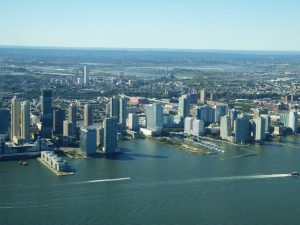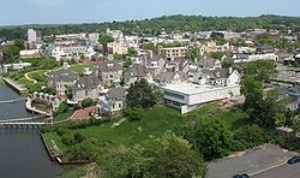New Jersey Future Blog
County Population Estimates: Return to the Urban Core Continues
March 26th, 2018 by Tim Evans
Exurban counties continue to lose residents, while Hudson County hits a milestone

View of Jersey City from lower Manhattan. Hudson County hit a population milestone in the latest Census Bureau estimates of county populations.
According to new Census Bureau estimates, nine of New Jersey’s 21 counties lost population between 2016 and 2017. In descending order of the magnitude of the percentage loss, they are: Cumberland (-0.89 percent), Salem (-0.58 percent), Sussex (-0.43 percent), Cape May (-0.39 percent), Atlantic (-0.34 percent), Monmouth (-0.07 percent), Warren (-0.04 percent), and Camden and Hunterdon, both of which had very small losses that round to 0 percent. All nine of these counties also lost population in the previous year (from 2015 to 2016), although in most cases the 2016-17 loss was smaller than the 2015-16 loss; only Cumberland lost more people from 2016 to 2017 than it had from 2015 to 2016. (One county, Burlington, reversed course and went from losing people between 2015 and 2016 to gaining between 2016 and 2017.)
| County | Population Change 2015-2016 |
Population Change 2016-2017 |
|---|---|---|
| Atlantic | -0.83% | -0.34% |
| Bergen | +0.44% | +0.64% |
| Burlington | -0.11% | +0.06% |
| Camden | -0.01% | -0.00% |
| Cape May | -0.53% | -0.39% |
| Cumberland | -0.87% | -0.89% |
| Essex | +0.46% | +0.55% |
| Gloucester | +0.02% | +0.17% |
| Hudson | +0.95% | +0.77% |
| Hunterdon | -0.55% | -0.00% |
| Mercer | +0.15% | +0.29% |
| Middlesex | +0.20% | +0.33% |
| Monmouth | -0.10% | -0.07% |
| Morris | +0.06% | +0.17% |
| Ocean | +0.72% | +0.84% |
| Passaic | +0.07% | +0.26% |
| Salem | -0.90% | -0.58% |
| Somerset | +0.29% | +0.32% |
| Sussex | -0.71% | -0.43% |
| Union | +0.72% | +0.50% |
| Warren | -0.41% | -0.04% |
Nationally, three out of every seven counties (42.7 percent of counties) lost population, so the share of New Jersey’s counties that lost population exactly mirrors the country’s.
Hudson County hit a milestone as of 2017 — with its current population estimate sitting at 691,643, Hudson has now surpassed its previous population peak of 690,730, which it had achieved all the way back in 1930. It took 87 years, but Hudson County has gained back all of the population it lost during the era of suburbanization and de-industrialization, after falling to a low of 553,099 in 1990. Redevelopment is slowly repopulating the state’s urban centers and older suburbs, which suffered from suburban out-migration in the latter half of the 20th century. (Union County also earlier this decade surpassed its previous population peak, which it had achieved in 1971.)
The state’s more urban counties are generally faring much better than the exurban ones, as has been the case since the Great Recession of 2008. Outlying Ocean County was the fastest-growing county in the state (+0.84 percent) again this year, as it was between 2015 and 2016, but the next five top positions are all held by counties of the North Jersey urban core: Hudson (+0.77 percent), Bergen (+0.64 percent), Essex (+0.55 percent), Union (+0.50 percent), and Middlesex (+0.33 percent). All of these grew faster than the statewide growth rate of 0.30 percent. All of them also grew faster than Somerset County, which had been the fastest growing county in the 1990s, and faster than Gloucester County, which had the highest growth rate between 2000 and 2008.
The New Jersey counties losing population over the last year include all of the counties that are farthest from the state’s two core urban areas: Atlantic, Cape May, Cumberland, and Salem in the south, and Sussex, Warren, and Hunterdon in the north. These northern counties represent the formerly fast-growing exurban fringe of the New York metro area, now faltering as the Millennial generation increasingly opts for more walkable urban areas.
Hudson County’s resurgence is emblematic of the return of population growth to built-out counties that has taken place since 2008. While Ocean County may have claimed the top spot the last two years, It ranks only in sixth place for growth rate for the entire 2008-2017 period. Hudson, Union, Bergen, Middlesex, and Somerset take the top five spots for post-Great Recession growth, and Essex and Passaic rank seventh and eighth. This is a 180-degree turnaround for the North Jersey urban counties; Hudson, Bergen, Union, Passaic, and Essex counties all ranked among the seven slowest-growing counties between 2000 and 2008.















